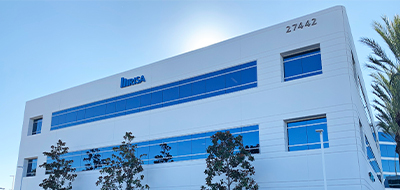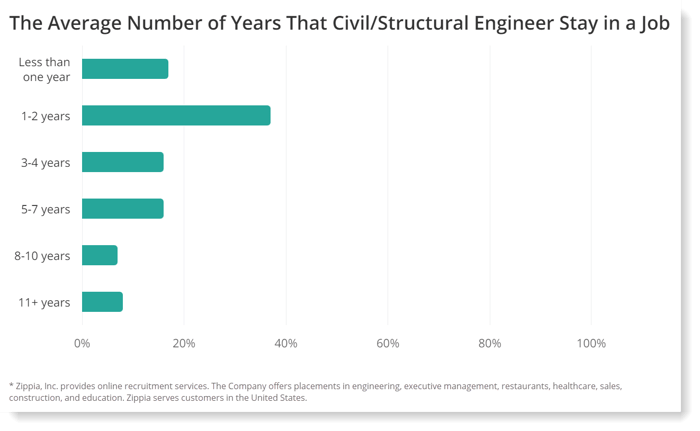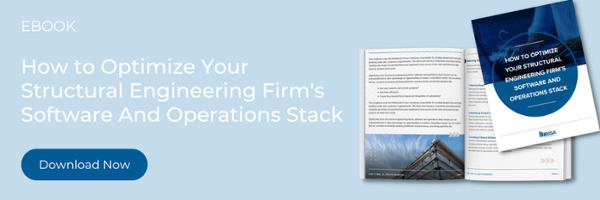Your engineers are the lifeblood of your company, responsible for creating designs that meet both building code and customer requirements. The time and resource constraints associated with this complex job make it essential that your engineers have access to the tools and resources they need to do their best work.
Optimizing your structural engineering firm's software and operations stack ensures you are well-positioned to take advantage of opportunities in today's competitive market. You can achieve this by carefully reviewing existing platforms and processes, answering questions like:
- Do your systems serve their purpose?
- Are they efficient?
- Could they benefit from improved integration or automation?
Why You Should Optimize Your Structural Engineering Firm’s Software and Operations
Optimizing your structural engineering firm’s software and operations is a must for realizing the full potential of your firm. Why should optimization be at the top of your priority list?
- Reduce Costs
Optimizing reduces unnecessary costs that drain your resources. You can identify inefficiencies and eliminate them through careful evaluation and analysis of existing systems, software solutions, and processes. Eliminating inefficiencies leads to fewer expenses in labor, onboarding, project management, administrative duties, and other areas. - Streamline Workflows
Optimization improves efficiency throughout all areas of the company. By streamlining workflow processes and cutting out redundancies in existing software, engineers can work more productively and effectively, which allows them to focus on completing projects both accurately and on time. - Compliance and Risk Mitigation
Optimization helps comply with industry standards and regulations. Keeping pace with current trends in the structural engineering field is essential for remaining competitive. Ensuring your systems and processes are up-to-date significantly reduces the risk of non-compliance and associated wasted resources.
Reducing Costs by Increasing Efficiency
Reducing costs while increasing efficiency is paramount in any engineering project. To achieve this, the team must leverage existing skills to maximize their time and energy. Ways to increase efficiency include:
- Retaining Good Engineers
Keeping good engineers is critical and reduces the costs associated with recruiting, hiring and onboarding new engineers. Additionally, experienced engineers can become more efficient in their work because they are familiar with the processes and tools used by their teams. Keeping existing engineers engaged is also important: when employees feel valued, motivated, and supported within their team, they tend to stay longer and contribute more value. - Maintaining Trusted Vendors
Having trusted vendors to provide reliable and cost-effective solutions saves engineering teams valuable hours from researching the best options available for each project. For example, switching to a vendor that offers an all-in-one structural engineering software package can reduce costs dramatically by eliminating the need to purchase multiple pieces of software from different vendors. - Investing in Robust Software
Investing in sophisticated software helps to maintain efficiency by reducing manual workloads and automating repetitive tasks, which translates into faster turnaround times and improved accuracy of work. Furthermore, having a well-trained staff familiar with the tools allows them to stay ahead of the competition.
Focus On a Project Niche
Focusing on a particular project niche as an engineering firm can offer numerous benefits. Not only does it allow you to hone in on and build up your expertise in a certain area, but it helps you maximize resources and create a portfolio of successful projects quickly.
For example, suppose you specialize in post-tensioned concrete or podium building design. In that case, your chosen software and design experience can reduce costs associated with a project while ensuring its success. Additionally, developing expertise within one particular industry can help boost your reputation among potential clients and help set yourself apart from other engineering firms still trying to develop their skill sets across multiple sectors.

4 Benefits of Focus
Focusing on a project niche can have tremendous benefits for your engineering firm as it allows you to:
- Develop Your Team
As your team's experience in a particular niche grows, you can be confident that your engineers will develop the best solutions while achieving maximum efficiency with minimal resources. This focus allows you to better serve the needs of clients and deliver superior results on time. It also makes attracting and hiring the right engineers for your projects, even easier. - Leverage Team Knowledge
Limiting your scope to one (or two) specific areas or industries lets you leverage your team's collective knowledge and create more accurate work with fewer, more effective tools. This focus allows you to build deeper relationships with other engineering functions and building trades, often resulting in improved collaboration and streamlined communication for projects. - Reduce Costs
Narrowing the scope of your project niche will help reduce costs by minimizing the type of structural engineering software you use, reducing the necessary training, and maybe even some discounts on licenses. - Win More Business
Creating a robust library of case studies or reference clients within your niche allows potential collaborators to see exactly how you approach similar problems. A deep understanding of a particular problem space makes it easier to apply your knowledge and skill set to future projects.
Hiring and Retaining Structural Engineers
Hiring and retaining structural engineers is not an easy task. Structural engineering is a demanding field that requires specialized knowledge and skills in order to design and build the complex structures that are used every day. As such, it’s not unusual for engineers to look for more challenging or rewarding work after a few years with the same employer.
In fact, engineer turnover is a real challenge in this industry, with high rates of burnout and headhunting common. Research shows that 37% of structural engineers leave their positions within two years (see chart below). This frequent turnover is difficult for employers attempting to build a successful and stable engineering team.
Retaining structural engineers is a challenge for any firm looking to keep their projects on track and maintain a high level of productivity. By investing in strategies that help retain engineers, companies can save money in the long run by avoiding costly project delays, in addition to recruiting and training costs.
SPK and Associates estimate that hiring a new engineer can cost up to $280,000 for a role that pays $100,000 per year. This shows how much money can be saved by retaining your employees.
Retention Strategies
There are several ways to effectively hire and retain structural engineers that can have lasting benefits for your business.
- When hiring structural engineers, it’s critical to look beyond a candidate’s qualifications or portfolio; you should also look for qualities like problem-solving skills, leadership ability, communication skills, and personal ambition.
- Given the high turnover rate of engineers, you should develop retention policies that incorporate recognition and development opportunities, such as providing access to career-building seminars/conferences as well as possible promotions. Additionally, formal recognition in front of peers and supervisors in addition to monetary and general reward incentives can bolster the retention rate for your firm.
- Structural engineering is an ever-evolving field so investing in continuing education is critical for existing and new staff. This can include workshops, conferences, or certificate programs to help them stay updated on the latest industry trends.
- Encouraging work-life balance, hybrid work schedules and a vacation-friendly work culture can also help with retention. It is well-known how overworked engineering teams can be and that there is often pressure to avoid taking time off to complete projects. This atmosphere leads to burnout and job dissatisfaction.
- Finally, create an environment where engineers feel supported and valued. You could offer mentorship programs, opportunities for all team members to voice input on critical decisions, and substantial resources for your engineers to succeed.

Hire the Right Engineers
Structural engineering requires a depth of experience and reliability other fields don't have to deal with. When hiring for this field, you must ensure your company has the best people to develop safe, code compliant projects, keep to budgets, and finish with the highest degree of efficiency and integrity.
While all of the technical requirements of a new employee are important, making sure that someone is a good fit for your company culture is also a necessary consideration. Whether hiring someone who has just graduated college or an engineer with years of experience, ensuring they are a fit your company and team is crucial. Emphasizing diversity and inclusion when looking for candidates is also important; having a diverse team allows for new perspectives and ideas which can be brought into the workplace and lead to better results. Diversity also resonates strongly with younger generations of talent entering the workforce, which helps in recruiting talent.
It's also necessary to ensure you have enough people on board with sufficient skill sets to complete upcoming projects. Additionally, it's critical to stay ahead of your people needs when it comes to upcoming projects. Often, hiring and onboarding times are not factored into these proposals, creating a situation where added pressure could lead employees to search for other opportunities.
Training
When it comes to training, several key aspects should be addressed:
- To ensure their success, engineers must receive comprehensive onboarding. This should include an overview of competency, performance, and responsibilities. It’s also important to provide ongoing training throughout their employment so they can stay up to date with code compliance, building materials, trends, and more.
- In addition to general knowledge, software tools are critical for engineers as their use can encompass a large portion of daily activities and project work. Robust software, ample resources, and professional training opportunities such as online or customized in-person courses make up a well-rounded training plan.
- Finally, it’s important to emphasize the value of teamwork and collaboration between engineers. For example, attending regular meetings or workshops that explore team dynamics and effective communication can help everyone work together better. Engineering teams are prone to communication and tribal knowledge issues, so taking steps to help everyone work together better is vital.
Engineering Software Tools and Support
When it comes to engineering, the software vendor, and tools they provide can make or break your projects.
Begin by ensuring your chosen software suite offers easy-to-use tools for your specific project needs. A good toolset could include 3D modeling, robust analysis capabilities, cutting edge simulation and optimization routines, BIM integration, and other features necessary for efficient project execution from start to finish. These tools should also be able to handle multiple projects within one software suite in order to reduce learning curves and mental switching costs.
In addition to effective tools, it is essential to have access to reliable support, such as vendor customer support and technical assistance, as well as industry resources, such as The Institution of Structural Engineers, American Institute of Steel Construction, American Society of Civil Engineers, and so on, that can provide guidance and best practices when complex issues arise.

Optimizing Your Toolkit
Optimizing your engineering toolkit can be a great way to improve efficiency, reduce costs, and maximize the effectiveness of your engineering team. When rationalizing your tools and processes, consider what you need in terms of software and support staff. You should make sure that you have the right tools for the job; those that are most suited for your engineering team and their projects. Additionally, your engineering team should be able to request and obtain timely assistance for any technical software issues that may arise.
Inventory what you have
Accurately inventorying the software you own can help you manage your licenses and ensure you don’t have duplicate software for similar tasks. You should thoroughly assess your software, how it was purchased, and what associated licenses are in place. Here’s how:
- Start by making a list of all the software in use at your organization - or potentially on any employee devices. Use a spreadsheet to list, including important details such as:
- Name and version number
- Licensee (whether it's for personal or company use)
- License Type (local or cloud-based)
- Usage frequency
- Purchase date
- Renewal billing dates, if applicable
- Support status (current, expired, or perpetual)
- Integration with other systems
- Survey your engineering team to find out what they're using.
- Review accounting systems or credit card statements to uncover potentially overlooked software subscriptions or purchases.
- You can also request reports from your IT department or software vendor to get a complete picture of what software is owned and in use.
This information will help you easily identify which licenses are necessary and which are superfluous. In some cases, you may even discover software that’s no longer in use but still takes up valuable resources and wastes money on license renewals or maintenance. Once you've completed the list, keep it current with regular audits to ensure accuracy and compliance with licensing regulations.
Evaluating the List
Now that you know what you have, you can evaluate whether a specific software is what your team needs. Consider the following and note opportunities to right-size your software:
- Interoperability: Can one primary structural engineering software suite work across multiple types of projects?? Can one software suite support 90% of the projects you have?
- License Count: Do you have the correct number of licenses? Does your software vendor provide usage stats that allow you to make decisions about increasing (or decreasing) license count.
- Product Fit: Does the software meet the needs for your current, and, more importantly, future projects? Consider upcoming project types and design trends such as podium structures, cold-formed steel, and post-tensioned concrete. Does your software work for at least 90% of your projects?
Did you know?
RISA is a powerful, versatile software suite allowing teams to design projects quickly and efficiently. More than 60% of structural engineers confidently use RISA within their workflows due to its support of a wide-range of use cases with a high degree of integrity and support. With RISA, users can easily integrate the building, foundation and connection design into one seamless and fully documented workflow.
———
- Effective Hardware: Do your engineers have the right kind of laptop, desktop, and peripheral hardware? Sometimes the simplest additions (like a second or third screen) can vastly improve efficiency.
- Training: Does your team have a majority software preference? Are they all equally confident using the same software? Does your software vendor provide loads of training options, including online and offline training?
- Support: Does the software have a robust support program? Is the support you receive for this software valuable beyond basic software support - meaning can they help with complex engineering questions rather than just a simple installation issue? Is their support responsive?
- Accuracy: Do you TRUST the data? Are the calculations and design methodologies transparent?

Manage Your Billing, Hours, and Receivables
To ensure that your engineers have the right software and time to learn it, you need to be constantly tracking their time and billing. This will enable you to optimize the number of billable hours available so they don’t waste time learning while working on a project.
To manage your billing, hours, and receivables effectively, consider using dedicated software solutions that can help you track total billable hours per day or week for each engineer.
Minimize Learning Curves
Every time a new engineer comes on board or must learn a new system, it costs time and money, and billable time is compromised. Minimizing the learning curve reduces overhead expenses and improves your firm's efficiency. Ways to minimize learning curves include:
- Establish Clear Procedures and Expectations:
Having well-defined standard operating procedures (SOPs) can help keep employees on track while getting used to a new tool or process. By having comprehensive SOPs in place, you can ensure everyone understands their responsibilities and how workflows should be carried out. Additionally, it gives team members a point of reference if there are any questions or issues. - Simplify Processes:
When processes are overly complex, it slows down learning and increases frustration. By breaking down the process into smaller tasks and creating easy-to-follow guidelines, your team can quickly get up to speed on tools—which goes a long way in retaining engineers! - Minimize Software Solutions:
Switching between different software platforms can take time and effort. By choosing a single vendor with an integrated approach to the engineering design process (like RISA), your team can quickly get up-to-speed and even accelerate your project timelines.
Solid Time Tracking Software
Engineers need to be able to track their hours and any tasks they have completed to accurately report their time for billing purposes and for accurate completion of projects. Solid time tracking software allows engineers to easily log and monitor time with simple documentation that other team members or clients can use. This improves team collaboration as well.
Good time tracking software gives engineers the ability to customize their workflow, allowing them to set more specific and accurate deadlines. With detailed project information available at-a-glance, it is easier for engineers to track their progress and meet those deadlines. Because of this added visibility, teams can better allocate resources for each task or project so that work can be completed on schedule and higher quality projects delivered in less time.
Bill Them Properly and On Time
Good billing practices and the appropriate use of the collections process can be critical components to the success of any business. Effective billing processes ensure customers are charged correctly, payment terms are clear, and that cash flow is maintained on an ongoing basis.
To begin with, it’s important to create accurate invoices in a timely manner that outline the services provided and corresponding costs. Payment terms should also be clearly articulated so customers understand when payment is due; this will help reduce confusion and decrease the chances of delinquency down the road. Additionally, especially for businesses that offer recurring services or bill clients monthly, consider sending out friendly reminders once an invoice reaches its due date to further encourage prompt payments from clients.
The Collections Process
However, despite these efforts, there’s always the potential that some customers may not pay on time. This is where having an appropriate collections process in play can be invaluable. Depending on your business model and the terms you’ve agreed to with customers, a collections process can involve anything from sending out additional invoices or late payment notices, placing follow-up phone calls or emails, to taking legal action if necessary.
Having a solid understanding of when and how to apply the various processes involved with collecting payment can be key to reducing customer delinquency and preserving cash flow. Being firm yet respectful of customers’ needs is essential during this process, but it’s also important to collect payment, and that is where a customer portal can be invaluable.
Did you know?
With RISA's Customer Portal, you can easily manage your billing information and pay your annual renewal in just a few clicks. You'll also be able to manage users and their usage so that you can always be sure that your company owns the correct number of licenses. This robust, online platform even allows users to explore new products through 10-day trials, and when ready purchase the software they need to get their projects done.
———
Conclusion
By reviewing tools and processes, you can ensure that you are using the best applications for each task and streamlining where possible. This leads to improved employee morale, greater productivity, reduced costs, better project delivery, and higher profits.
Ultimately, by investing in the right technology and resources for your firm’s specific needs, you can create a profitable operational strategy that boosts overall performance. So don't let another day go by without giving your structural engineering firm’s software and operations stack the attention it deserves - start optimizing today!







